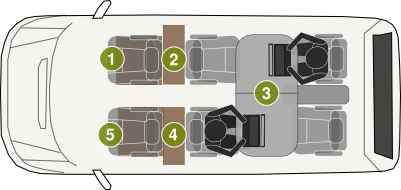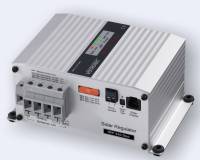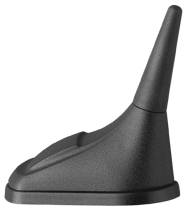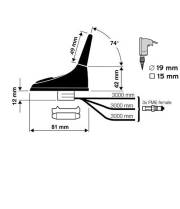Table of Contents
Odyssey (Command-Module)
Vehicle
Vehicle Specifications
| Attribute | Value | Schematics |
|---|---|---|
| Model | V 220 CDI |  |
| Motor | OM 611 DE 22 LA | |
| Capacity | 2148 cm³ | |
| Cylinder/Valves | R4/16 | |
| Power @ min-1 | 90 kW/3800 | |
| Torque @ min-1 | 300 Nm/1800–2500 | |
| Build | 2002 | |
| HSN | 0710 | |
| TSN | 558 |
On-Board Systems
Energy
Apollo-NG is designed to operate fully autonomous and self-sustainable in its function as a Hackerspace and also as habitat for crew and joining hackers. Each module (CM/LM) must be able to sustain and support itself and both modules are designed to share and work together when combined to increase efficiency and redundancy.
In order to reduce the risk of power unavailability and to inspire research on different energy conversion techniques it seemed reasonable to diversify:
- Base-level energy support is covered by solar-panels (PV), since they are always ready to operate, as long as the sun is shining.
- Using helios to provide additional power by burning available biomass
- Using TEG's on the vehicles exhaust system for solid-state heat→electrical conversion
Rational thinking will ultimately come to the conclusion, that increasing efficiency and diversity is not going to be enough to keep a fully self-sustainable and autonomous state. Therefore, all power consuming use cases and their underlying technology, have to be constantly monitored by the SKU and optimized to fit into the conservative power budget of 50W maximum consumption for 10 hours per day (500Wh/day).
Modern technologies like LED's, embedded SoC devices and highly efficient switch-mode power supplies make this possible and are being continously evolved and tested.
Solar
Since solar power is the primary energy source of the Odyssey, the primary design considerations have been efficiency and reliability. Although there seem to be advances in solar technology, biggest challenge was to find solar panels with at least 20% conversion efficiency that actually would physically fit on the constrained roof space of the Odyssey. After a long and thorough market analysis, the following components have been selected and obtained to supply the Odyssey with solar energy.
Panels
It seems that these days, most panels are produced in a very limited subset of available sizes, streamlined for the grid-feed solar market, which are too long to be mounted on the roof of a regular vehicle and would stand over the sides. The supply market for grid-feeding solar systems is huge but there are only a few (mostly smaller) companies offering off-grid solutions.
Mobile Technology MT-ST110
| Parameter | Single Panel | Combined |
|---|---|---|
| Nominal Peak Power @ 1 kW/m² RSO (25°C) | 110 Wp | 330 Wp |
| Efficiency | 20% | |
| Short-circuit current | 6.1 A | 18.3 A |
| Idle-Voltage | 22 V | 22 V |
| Cells | 36 Mono | 108 Mono |
| Cell-Size | 13×13 cm | |
| Panel-Size | 125x55x3.3 cm | |
| Weight | 8.3 KG | 24.9 KG |
| Source | Büttner Elektronik | |
Calculations & Simulation
The panel's surface is a little bit larger than the actual cell surface. The following calculations were based on a combined photo-active area of about 1.825 m², by measuring and multiplying the size of a single cell.
<x 14>0.13*0.13*108 = 1.825 m²</x>
Assuming a maximum of 1000W of energy per m2 delivered by the sun on the planet's surface, the Odyssey's available combined photo-active roof surface (1.825 m²) can theoretically receive a maximum of 1825 Wp (Watt Peak), in peak sunlight:
<x 14>1.825*1000=1825 Wp</x>
In mid-summer at peak sunlight (1000W/m² Global Solar Radaition), the Odyssey will receive about 1.8 kW of solar energy on all cells. The conversion efficiency for these modules is rated at 20% by the manufacturer. Knowing that, it's possible to calculate the maximum amount of power the Odyssey can harvest with her finite roof-space at 20% module efficiency. Of course, the cell efficiency will be slightly higher:
<x 14>1825*0.2 = 365 Wp</x>
Now for the sake of going through it, lets further assume a luxuriously sunny, clear-sky day and the opportunity to harvest 4 hours at maximum peak output, the solar power-budget will accumulate about 1460 Wh (110 Ah).
<x 14>365 * 4 = 1460 Wh \approx 110 Ah</x>
Although the panels will not stop converting energy after the peak four hours, the current will probably drop soon enough. As of now there is still not enough data to conclude anything but simulations with the UCSSPM in the VFCC are helping to get an estimation.
Solar Charging Controller with MPPT
Votronic MPP 420 Duo Digital
| Parameter | Value |
|---|---|
| Nominal Operating Voltage (AC) in [V] | 12 |
| Capacity Solar Module max. [Wp] | 420 |
| Current Solar Module max. [A] | 25.0 |
| Voltage Solar Module max. [V] | 50 |
| Charging Current Batt. I / II max. [A] | 32.0 / 1.0 |
| Characteristic Line of Charging | IU1oU2 |
| Battery Type adjustable | Acid/Lead-Acid, Gel, AGM |
| Current Consumption Stand-by in [A] | 0.0045 |
| Overcharge Protection | yes |
| Reverse Current Protection (during the night) | yes |
| On-board mains suppression filter | yes |
| Number of Charging Ports | 2 |
| Protection against Overload, Overtemperature, Short-circuit | yes |
| Connection for Temperature Sensor | yes |
| Compensation of voltage loss on charging cables | yes |
| Connection for LCD-Solar-Computer | yes |
| Temperature Range [°C] | -20 to +45 |
| Dimensions (WxDxH) in [mm] | 160 x 71 x 100 |
| Weight in [g] | 680 |
Biomass
Real-World prototyping and testing of helios
Excess Heat
A good way to harvest additional power to charge the battery would be to add TEG's to Odyssey's primary engine exhaust system, thereby increasing the overall efficiency of burning fuel without the need to burn even more fuel in contrast to harvesting power from the alternator.
Alternator
In emergency situations or other irregular energy shortages a boost converter can charge the battery by harvesting power from the Odysseys's alternator. As this will increase the fuel consumption of the vehicle, it's only going to be used when absolutely necessary, i.e. when the battery is empty and the Odyssey is moving at night (no solar power).
The SKU will use navigation system data to predict how much driving time is needed to re-charge the battery to be operational on arrival and will then recommend to use the Votronic VCC 1212-25 IU boost converter to charge the battery, trying to balance the increased cost of fuel consumption.
| Charging Capacity in [V]/[A] | 12/25 |
| Max. Current in [A] | 40 |
| Input Voltage in [V] | 11 - 16 |
| Battery Type adjustable | lead-acid, lead-gel or lead-AGM1 / AGM2 |
| Nominal Battery voltage IN in [V] | 12 |
| Battery Capacity IN in [Ah] | 60 |
| Power Consumption IN (AC) in max. [W] | 480 |
| Nominal Battery voltage OUT in [V] | 12 |
| Battery Capacity OUT in [Ah] | 50-200 |
| Characteristic Line of Charging | IU1oU2 |
| Overvoltage Disconnection | yes |
| Ripple Factor Voltage in [mV] rms | <30 |
| Dimensions (WxDxH) in [mm] | 160 x 71 x 245 |
| Weight in [g] | 1450 |
http://votronic.de/index.php/en/products2/series-vcc/standard-version/vcc-1212-25
The boost converter is needed to provide the necessary 14.4V charge voltage needed by the AGM battery to reach its maximum capacity.
Batteries
Winner Protheus AGM 270Ah - Thanks to Nep for the Donation :)
On-Grid
- Smart Grid Controller Module (SGC)
- Votronic PB 1240 SMT 3B charge controller
The bulk of onboard systems is modularized into several units which reside in a half 19“ 3HE rack, using common DIN-EN/IEC 60603-2C connectors for in system power and signal distribution.
Each unit also carries a Dallas 18S20 digital temperature sensor, connected to the SKU's 1-Wire Bus for centralized temperature monitoring and to identify each module, since each sensor has a unique ID. That makes it possible to let the SKU know, which modules are present.
To reduce fuel consumption, all subsystems are powered by the secondary battery in order to minimize the power demand of the alternator on the primary engine.
Modules
Power Distribution Unit (PDU)
A flexible configuration is only as good as the least flexible part of the chain. In order to keep future changes in mind, the system had to have a central power distribution unit and highly-efficient subsystem voltage converters. The PDU also acts as a monitoring device for the SKU on all relevant power in/outlet buses. See the pdu page for more details.
Station Keeping Unit (SKU)
The purpose of the SKU is to monitor, analyze and control all of Odyssey's subsystems as well as to provide basic system features (i.e. GPS, Time, Networking, System-Watchdogs). It will also monitor and record habitual & mobile environmental (external/internal) sensor data, develop power consumption profiles to recommend either a change in power usage behaviour or a change in power harvesting methods to maximize efficiency. Read more on the sku page.
Main Computing Unit (MCU)
User Interface
Multimedia
One of the bigger challenges in terms of power budget was the audio system. Having the ability to listen to music or other audio material seemed kind of essentiell and almost all current implementations of pre-amp/amp designs (Class A,B,A/B or D) were undesirable either due to power or audiophile constraints - they either drew too much power or the sound quality was totally inacceptable or both.
More details on the audio page.
Navigation
- Navit
- Front Display
Networking & Communication
LAN
D-Link DGS-1008D G3 Gigabit-Ethernet Switch
- 8 1GB ethnernet ports
- Very low power consumption




